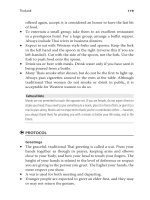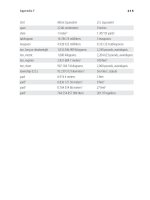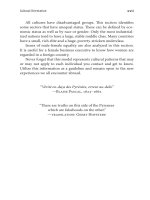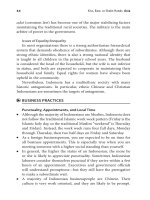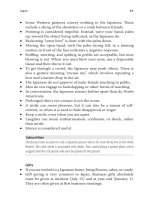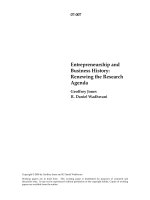Business Processes for Business Communities: Modeling Languages, Methods, Tools doc
Bạn đang xem bản rút gọn của tài liệu. Xem và tải ngay bản đầy đủ của tài liệu tại đây (5.77 MB, 200 trang )
Business Processes for Business Communities
i
Frank Sch
¨
onthaler
Gottfried Vossen
Andreas Oberweis
Thomas Karle
Business Processes
for Business Communities
Modeling Languages, Methods, Tools
123
Dr. Frank Sch
¨
onthaler
PROMATIS software GmbH
Ettlingen
Germany
Prof. Dr. Gottfried Vossen
University of M¨unster
Information Systems
M¨unster
Germany
Prof. Dr. Andreas Oberweis
Karlsruhe Institute of Technology (KIT)
Institut AIFB
Hertzstr.
Karlsruhe
Germany
Thomas Karle
PROMATIS software GmbH
Business Applications Division
Ettlingen
Germany
The original German edition was published in 2010 by Oldenbourg Wissenschaftsverlag.
ISBN 978-3-642-24790-3 e-ISBN 978-3-642-24791-0
DOI 10.1007/978-3-642-24791-0
Springer Heidelberg Dordrecht London New York
Library of Congress Control Number: 2012934814
c
Springer-Verlag Berlin Heidelberg 2012
This work is subject to copyright. All rights are reserved, whether the whole or part of the material is
concerned, specifically the rights of translation, reprinting, reuse of illustrations, recitation, broadcasting,
reproduction on microfilm or in any other way, and storage in data banks. Duplication of this publication
or parts thereof is permitted only under the provisions of the German Copyright Law of September 9,
1965, in its current version, and permission for use must always be obtained from Springer. Violations
are liable to prosecution under the German Copyright Law.
The use of general descriptive names, registered names, trademarks, etc. in this publication does not
imply, even in the absence of a specific statement, that such names are exempt from the relevant protective
laws and regulations and therefore free for general use.
Printed on acid-free paper
Springer is part of Springer Science+Business Media (www.springer.com)
Preface
For my children, Sabrina and Marcel, who have always given me
the strength to master difficult challenges with confidence.
Frank Sch
¨
onthaler
Inspired by first successful practical projects in Central European financial
service and industrial enterprises, two of the authors of this book—Andreas
Oberweis and Frank Sch
¨
onthaler—started in the mid-1980s to develop methods and
software tools for business process modeling. It may have been attributed to the
aura of the time-honored Fridericiana University of Karlsruhe that a certain “sense
of mission” quickly spread out among the team of ambitious young researchers; it
was obvious that the whole world would soon use suitable methods and software
tools to create business process models. And even more: These models would
be created in a mathematically sound notation to be also amenable to formal
analyses and optimizations. Not only the sequence of operations aspects should
be described, but business processes should be included as a whole to be able to
depict resource requirements, responsibilities, business objects, and much more. In
short: The objective was to arrive at complete “business building plans” through
business process models. And why should the design and optimization of enterprises
not be as successful with what has been common practice for thousands of years
in technical design? And usually the technical design has much less complex
structures than what a business represents today. However, what was obvious to
young researchers then had in reality not or only partially confirmed itself. Busi-
ness processes are today’s lynchpin, concerning changes in enterprises. Business
reengineering, implementation of business software systems (ERP, CRM, SCM,
etc.), business process management, governance, risk, and compliance management,
just to mention a few current topics, are unthinkable without a thorough examination
of business processes. In addition, all technical innovations are scrutinized first for
their suitability to influence a customer’s business processes in a positive manner.
Indeed, varieties of business process tools have appeared on the market within the
last decades. The authors of this book have themselves had the experts sit up and
v
vi Preface
take notice with a promising high-end tool. Yet a glance cast behind the scenes
and an analysis of the productive use of the tools causes quick disillusionment:
While trained business process experts are using the tools successfully in enterprises
and consulting firms, the majority of “business process workers” use the business
process tool No. 1: Microsoft Office Suite! With adventurous description lists,
cross-reference matrices, and informal schematic images, an attempt is launched
to master the complexity of a company’s business processes, to highlight potential
for optimization, and to provide a solid basis for the development of supporting
information systems. It may sound exaggerated, but the authors have seen, in
practice, a number of such business process descriptions, which have been the basis
of large-scale projects in the two-digit million Euro range. Quite a number of these
projects, with which the clients had connected high hopes, expecting these to be the
driver for further corporate development, ended up as a costly mistake.
These essential experiences in practice have been the starting point and the basis
of an intensive exchange of ideas between the practice representatives, the college
lecturers, and researchers in the authors’ circle. Why is it that the use of business
process tools remains limited to a relatively small circle of experts? Why do so
many projects fail due to problems which obviously could have been avoided by
using suitable methods and tools? What contribution can social networks make
in connection with modern web technologies to promote the “business process
culture” in the enterprises? But it should not remain with just the exchange of
ideas to answer these pressing questions: In the research and developer network
Horus
R
Endeavor
TM
, groups from Karlsruhe Institute of Technology (Andreas
Oberweis), the University of M¨unster (Gottfried Vossen), the University of Applied
Sciences in Konstanz (Marco Mevius), the FZI Research Center for Computer
Science in Karlsruhe, as well as the industrial partner Horus software GmbH, have
joined forces to develop ideas for innovative business process methods and software
tools. Results of this continuing research activity of several years have led to the
development of the Horus
R
Method
TM
and Horus
R
business process tools. To
preclude “cost barriers,” the Horus
R
tools are freely accessible in a fully functional
freeware version for research and education, and also for practical project use. In
addition, a professional distribution (Horus Enterprise) can be obtained from Horus
software GmbH.
But how can many potential users of business process instruments be possibly
reached? To answer this question reliably, this target group must be clearly defined.
The bottom line is: The target group proves to be extremely heterogeneous, if not
“diffuse.” Of course, it includes business consultants, organization and IT depart-
ment employees, and, not to forget, management assistants. However, returning
to our initial considerations, it becomes clear that specialists and executives in
the business departments, who develop business process ideas and play a part in
their implementation, also belong to the target group. They are often referred to as
key users, as ultimately they are the key for the implementation of new business
processes or process changes throughout the organization. The obvious diffusion
of the target group has led us to the consideration that it is much easier to reach
the potential users as part of their university education before being discharged
Preface vii
into practice to pursue different career paths. Moreover, what could be better than
providing a reference book that can be used as a basis for lectures and internships?
This reference book should provide extensive practical experience, so that valuable
support in practical work can be afforded. We would like to emphasize that the book
is not primarily aimed at computer specialists and, therefore, requires no computer
science knowledge. It is rather a business book that addresses management experts
and industrial engineers as well as computer scientists, business information spe-
cialists and information experts, and also engineers in business process questions.
After a brief introduction to the topic, the book offers a quick start into
model-based business process engineering in Chap. 2. In Chap. 3, the foundations
of the modeling languages used are conveyed. Meaningful examples are in the
foreground—each of the underlying formalisms is treated only as far as needed.
Chapter 4 describes the Horus method. The book defines a sequence of activities
which finally leads to the creation of a complete business process model. The Horus
method, incidentally, is not bound to the use of the Horus software tools. It can be
used with other tools or, if necessary, be used even without tool support. Important
application fields of business process engineering are described in Chap. 5.The
spectrum ranges from business process reengineering to the development and
implementation of information systems. The book concludes with an outlook on
the future of business process engineering and highlights current research activities
of the Horus Endeavor partners.
The book can be read either in context or as a whole, and specifically chapter by
chapter. The different possibilities of the book’s usage will be described in this short
guide:
• Short and concise: Are you looking for a management summary? Then have fun
with Chaps. 1 and 2.
• The languages or the fast Horus user: Does your interest lie in modeling
languages used without wanting to embed these in a comprehensive business
process engineering procedure? A question which the typical Horus freeware
user might answer with “yes.” Then refer to Chap. 3, whereas reading Chap. 2
beforehand might make the entry considerably easier.
• The method: Do you already have experience with modeling languages used
in business process engineering but want to learn how one can embed these
languages in a gradual procedure? You should then start directly with Chap. 4.
• The meticulous Horus user: You have downloaded the Horus software and would
like to enjoy a solid introduction before starting. Then you should start with
Chap. 2 and work up to and including Chap. 4.
• The professional business process engineer: The professionals in business
process engineering would like to inform themselves quite specifically about
different uses and experiences. These readers are referred to Chap. 5.
• The innovative one: You understand business process engineering but wish
to inform yourself about future topics and current research projects. Then go
directly to Chap. 6. If you have further questions regarding secondary informa-
tion or collaborations, please turn to the Horus Endeavor partners involved.
viii Preface
• Last, but not least: You would like to produce a video clip covering the topic
of “enterprise routine today.” Chapter 1 is then wholeheartedly recommended,
asking that you reward us by kindly including a note of thanks in the film trailer.
In this book, we refer to productsprotected by trademark law and are entitled to their
respective owners. These include software products from the following enterprises:
Horus software GmbH, Ettlingen, Germany; Oracle Corp., Redwood Shores, CA,
USA, and PROMATIS software GmbH, Ettlingen, Germany. Anonymous project
examples and excerpts from Horus Knowledge Bases are provided by courtesy
of PROMATIS software GmbH, Ettlingen, Germany, and Horus software GmbH,
Ettlingen, Germany.
Acknowledgements
An achievement such as this book can never be the result of just a small group
of authors. Many contribute without knowing it. The first to be mentioned in this
regard are the customers of PROMATIS software GmbH, who have provided the
“playing field” for the practice testing of the concepts and products introduced.
Thanks also go out to the many colleagues, the scientific and student employees of
Horus Endeavor partners that have developed and applied the described in practice.
Also, the students who have made valuable contributions to the knowledge of the
authors by their active cooperation in lectures, exercises, and training are thanked.
During B Semester 2011, the latest version of the text was successfully class-tested
at the University of Waikato Management School, Department of Management
Systems, courses MSYS355 E-Business Process Redesign and MSYS455 Advanced
E-Business Process Redesign in Hamilton, New Zealand.
A special thanks to the Horus development team, at the very front Yu Li,
Johannes Michler, Michael Pergande, and Thomas Schuster, who have implemented
the ideas of this book into high-quality software tools. Notable is the high quality
and productivity of this collaborative development team. This statement equally
applies to Sabine Schwarz, who is responsible for creating and optimizing the
numerous illustrations, and to Tanya Quintieri for the laborious translation work.
Ettlingen, Germany Frank Sch¨onthaler
M¨unster, Germany Gottfried Vossen
Hamilton, New Zealand
Karlsruhe, Germany Andreas Oberweis
Ettlingen, Germany Thomas Karle
Contents
1 Introduction 1
1.1 Everyday Enterprise Routine: Bad Atmosphere at
Confusio Corp. 1
1.1.1 Structuring the Problem 2
1.1.2 The Solution 2
1.1.3 What It Is All About 3
1.2 Modeling Languages and Methods 3
1.2.1 Language of the Business Community 3
1.2.2 Modeling Methods 5
1.3 Tools for Business Communities 5
1.3.1 Market Development 5
1.3.2 Horus: Business Processes for Business Communities 6
1.4 Objectives and Structure of This Book 7
1.5 Bibliographical Notes and Web Links 8
2 Practical Introduction to Business Process Engineering 9
2.1 The Task 9
2.2 Analysis and Modeling of Processes 10
2.2.1 Process Modeling with Petri Nets 10
2.2.2 Refinement of the Process Model 12
2.3 Business Objects and Object Flows 13
2.3.1 Creation of an Object Model 14
2.3.2 Typing of Objects 15
2.4 Process-Oriented Organization Structures 16
2.5 Holistic Business Process Management 18
2.6 Bibliographic Notes 20
3 Concepts and Modeling Languages 21
3.1 Introduction 22
3.1.1 Modeling 22
3.1.2 Simulation 23
ix
x Contents
3.1.3 Analysis 23
3.1.4 Monitoring 24
3.2 Business Process Modeling Views 24
3.3 Modeling Constructs for Business Processes 29
3.3.1 Elements of Procedure Modeling 30
3.3.2 Dynamics in Procedure Models 32
3.3.3 Procedure Types 35
3.3.4 Refinement 38
3.3.5 Object Stores in Petri Nets: XML Nets 39
3.4 Object Modeling 42
3.4.1 Requirements 42
3.4.2 Notation Used 43
3.4.3 Simple and Complex Objects 48
3.4.4 Assignment of Objects to XML Nets 50
3.5 Organization Modeling 50
3.6 Case Study 52
3.7 Self Control 55
3.8 Bibliographical References and Web Links 59
4 The Horus Method 61
4.1 Principles of the Horus Method 61
4.1.1 How to Apply the Modeling Language 62
4.1.2 Abstraction Principle 63
4.1.3 Structuring Principle 64
4.2 Phase 1: From a Mission to an Architecture Model 66
4.2.1 Context Analysis 68
4.2.2 SWOT Analysis 73
4.2.3 Strategy Analysis 74
4.2.4 Modeling an Enterprise Architecture 77
4.2.5 System Architecture Design 82
4.3 Phase 2: Business Process Analysis 83
4.3.1 Structure Analysis 85
4.3.2 Procedure Analysis 87
4.3.3 Organization Structure Analysis 91
4.3.4 Key Figure Analysis 94
4.3.5 Risk Analysis 96
4.4 Simulation 98
4.4.1 The Simulation Cycle 99
4.4.2 Application Areas 100
4.4.3 Creation and Parameterization of Model Variants 102
4.4.4 Simulation with Added Value, Costs, Time, and Quality 110
4.4.5 Analysis of Simulation Runs 115
4.5 Business Process Management and Process Implementation 118
4.5.1 Business Process Management Within the Horus Method 119
4.5.2 Abstract Implementation of Business Processes 121
Contents xi
4.5.3 Orchestration of Business Services 123
4.5.4 Physical Implementation of Business Services 124
4.5.5 Business Process Portals and Business
Performance Management 127
4.6 Best Practice and Reference Models 129
4.6.1 Industry Business Process Models 130
4.6.2 Best Practice Business Service Models 132
4.7 Self-Control 135
4.8 Bibliographic References and Web Links 135
5 Areas of Application 137
5.1 Business Process Reengineering 138
5.1.1 Drivers and External Factors 138
5.1.2 Business Performance Management 140
5.1.3 Model-Based Business Process Reengineering 140
5.1.4 Use of Reference Models 143
5.2 Business Process Management and SOA 144
5.2.1 Interactions Between Business and IT 144
5.2.2 Model-Driven Implementation of an SOA 145
5.2.3 Best Practices and Reference Models for SOA 147
5.3 Process-Oriented Introduction of Business Software 149
5.3.1 Why the Introduction of a Business Software Is Difficult 149
5.3.2 Model-Driven, Service-Oriented
Implementation Approach 150
5.3.3 Practical Use of a Business Service Reference Model 151
5.3.4 Migration of a Business Software 153
5.4 Governance, Risk and Compliance 157
5.4.1 Influencing Factors and GRC Mechanisms 158
5.4.2 Implementation of GRC in an Organizational Context 159
5.4.3 Prevention of Information Islands 160
5.5 Managed Services and ITIL 161
5.5.1 Outsourcing vs. Managed Services 162
5.5.2 Structuring of the Solution 163
5.5.3 ITIL: Reference Model-Based Service
Specification 164
5.6 Business Process Outsourcing 166
5.6.1 Typical Fields of Application 167
5.6.2 Basic Principle of Business Process Outsourcing 168
5.6.3 Model-Based Planning and Implementation of
BPO Contracts 170
5.7 Self-Control 172
5.8 Bibliographic References and Web Links 172
6 On the Future of Business Process Engineering 175
6.1 Virtual Worlds 175
6.2 Three-Dimensional Process Models 176
xii Contents
6.3 Semantic Processes 176
6.4 Social BPM 177
6.4.1 Socialization of Business Process Management 178
6.4.2 Web 2.0 Infrastructure for Social BPM 179
6.4.3 Collaborative Transactions 180
6.5 Self-Control 181
6.6 Bibliographic Notes 182
Bibliography 183
Index 187
Chapter 1
Introduction
1.1 Everyday Enterprise Routine: Bad Atmosphere
at Confusio Corporation
There is a bustling atmosphere in the headquarters of the globally active Confusio
Corporation. Everything seems to be just fine. Yet, there is a bad atmosphere in
the precious wood-paneled conference room of the managing director Paul Peppy.
Peppy has drummed together his top managers from all important branch offices; a
hard and uncompromising crackdown is urgently required! Concerning the topic of
the crisis summit, he has intentionally left the participants in the dark. The tension
is nearly unbearable, rumors make the round, one whispers about sinking margins
and organizational sloppiness. As Peppy finally flings the door open, he vigorously
enters the room, and his aggressive eyes fire off ominous flashes in the direction
of the sales managers; the culprits have already been identified. With current case
studies, which obviously caused his hair to stand on end, Peppy vents his anger
and lets the air in grow thin for his sales management. It is hard to believe, but the
US sales force has just thrown the German sales team out of the race in a tough
bidding competition for a global customer using dumping prices. Team Germany
had undercut the Asia team by more than 20% in Malaysia. The Asia team still
must be given some credit, as the customer had been classified as a lazy customer
in the credit analysis, which the German team missed.
A story from a fairy tale kingdom? Not at all—this is purely case practice!
Moreover, it could easily be conveyed to financial institutions, the public sector,
foundations, associations, and clubs. However, we want to see how Peppy and
his management team tackle the problem. Since the guilty parties were quickly
identified, those presumed innocent find a desire to express their opinion and begin
to dramatize the cases. The expected impacts on the margins are quickly quantified
and are projected to catastrophes with the medium of generalization. The sales
managers refer to individual cases and vow improvement. The discussion becomes
emotional, and threatens to escalate, when Peppy finally steps in and asks Fritz
Cunning, who is moving about in his seat uneasily, to structure the problem.
F. Sch
¨
onthaler et al., Business Processes for Business Communities,
DOI 10.1007/978-3-642-24791-0
1, © Springer-Verlag Berlin Heidelberg 2012
1
2 1 Introduction
1.1.1 Structuring the Problem
Cunning meets his bosses’ expectations. With the help of pin boards and flipcharts,
he at first starts to summarize and to structure the discussion points in a mind
map. He lists arguments, objectives, strengths, and weaknesses in structure trees.
Moreover, Fritz Cunning succeeds par excellence with what no one had expected:
He takes the edge out of the discussion and eliminates opposition by actively
engaging all those present into his analysis, creating transparency. Moreover, his
informal documentation techniques provide him with good services, since they
are simple and understandable and demand little abstraction capabilities from the
participants while developing a high visualization power. Peppy benevolently looks
at the results of his “secret weapon” Cunning. It is more than clear that the locally
optimal bidding process failed in the global context and a consequent reengineering
must take place. However, what must the new process look like for the proposal
system? In addition, how shall it be put into practice quickly and economically?
1.1.2 The Solution
All eyes are on Fritz Cunning, who once again has the advice and the proper tools
prepared. He relies on the technique of Petri nets, and with that he outlines the
essential features of the previous bidding procedure. Using this easy-to-understand
graphical model, he points to the weaknesses of the current process. By creating
a link to the documents that were jointly prepared during the previous informal
analysis, he easily manages to turn all the attendees into participants of this creative
engineering approach. Together, the idea of globalizing the bidding process is
developed and is additionally modeled in a Petri net.
And as usual, the overall satisfaction and acceptance quite quickly gives way to
skepticism. Of course, the new process seems convincing, someone throws in, but
the devil is in the details. Cunning refutes this argument because with Petri nets, he
has selected a technique that enables him to refine rough models arbitrarily to work
out the relevant details. The chief information officer points out that so much effort
would be put into a model that could potentially prove to be useless for future IT
implementation. Cunning counters with the automated implementation of Petri nets
into executable workflows and services. Somebody wants to know whether the new
business process also will be able to cope with the seasonally conditional load peaks
or if additional staff will become necessary. Cunning is pleased about this question,
because he can play out the essential strength of his Petri net approach, and promises
to resolve these questions using a simulation study and thus to provide quantitative
results and to visualize the model directly.
Peppy smiles contentedly, however secretly worried about whether the new
bidding procedure will really be economic, i.e., if the service quality valued by the
customers will be met or even surpassed and if cost savings will be possible. Prudent
Cunning anticipates his bosses’ worries and can help here as well. By means of static
1.2 Modeling Languages and Methods 3
analysis and dynamic simulation, he is able to directly show costs and benefits in his
Petri nets and offer solid forecasts for the profitability of the future business process.
1.1.3 What It Is All About
At this point, we leave the wood-paneled meeting room where the bad atmosphere
is no longer dominant. This small scene makes the importance of using effective
documentation and visualization techniques clear and that it is also important
to complement it with formal modeling instruments in organizational work. The
requirements placed on such instruments in terms of documentation requirements,
visualization, analysis, and simulation are fulfilled only when powerful software
tools are used. Petri nets offer the ideal platform for tool support and the scientific
maturity with their approved mathematical foundations for wide practical use.
1.2 Modeling Languages and Methods
In a globalized world, business processes increasingly form the crux of any
organization. Why is this so? Well, the explanation is comparatively simple, if
one considers that any change in an organization will be accompanied by changes
inseparable with its business processes. Changes in the global market are common
for the daily agenda: Companies are increasingly forced to adapt to new customers,
competitors, and business partners. Competitive edges are achieved more frequently
not by better products, but by efficient and cost-effective processes. In short,
business processes have developed into an additional factor of production.
1.2.1 Language of the Business Community
Given this background, it is no surprise that of all the professionals and managers
today, but also the IT staff, suppliers, and sometimes even the customers of
a company—we collectively call this the business community—are expected to
have a good look at business processes. Together, they contribute to the design,
analysis, documentation, execution, and further development of business processes.
Of course, this only succeeds if an efficient communication is possible. This requires
that the same language is used within the entire business community and that
time-consuming and error-prone translation operations are omitted. However, what
does this look like in practice? Obscurities, contradictions, misunderstandings, and
omissions in communication are common. Each interest group in the business
community maintains its group-specific perspective on a business process: The
management focuses on business performance indicators, business professionals
4 1 Introduction
have their business applications and processes in mind, and IT professionals think
in software and hardware structures. It is clear that communication problems are
inevitable. In many organizations, one tries to remedy this with modeling experts
who “translate” the collected business requirements into process requirements,
summarizing these in vast and highly complex models. Such an approach gives the
appearance of professionalism and efficiency, and in fact, such “model monsters”
are often given the stamp of approval by the entire business community forming
the basis of organizational change. Many community members recognize the
implications of the “model monsters” at a point far too late when they have to live
with the organizational changes.
Figure 1.1 shows an alternative approach that is based on the use of a common
modeling language. This language is understood and (ideally) “spoken” fluently by
all members of the business community involved. This means that an explicit trans-
lation of the communication processes will not be necessary, and the abstraction of
group-specific perspectives as well as structuring of the contents conveyed can be
carried out individually by everyone involved.
Which prerequisites are necessary for such a universal modeling language? First,
it must be easy to learn and can be mastered by inexperienced users quickly and
reliably. The language must provide all technically relevant aspects of a business
process in detail. All this is possible only if the language has a simple syntax, which
requires a minimum number of language elements, and clearly defined semantics
that distinctly govern the use and interpretation of the elements.
When we apply these criteria to modeling languages used in common practice,
it is immediately clear why they can only be used by “experts”: With a variety
of modeling elements—mostly “spiced up” with pictographs (recognition effects
should suggest simplicity and create an understanding)—it is attempted to convey
abstract and
structure
Business
Processes
Aliquam ornare, wisi eget
luctus volutpat, ligula sem
congue quam, a hendrerit odio
velit rhoncus risus. Aliquam
rhoncus, tortor eget mollis
blandit, dolor dui dapibus
metus, vitae semper ipsum
magna vitae magna. Aliquam
tellus leo, pharetra ac,
pharetra sit amet
Fig. 1.1 A common language as a prerequisite for communication
1.3 Tools for Business Communities 5
a clear view of reality in every conceivable application field. This proliferation of
syntax will be paid for with a strikingly vague definition of semantics.
A look into the related field of data modeling shows that this is the wrong
path. There, a mathematically sound model has established itself as an industry
standard with the relational database model by Ted Codd and the accompanying
query language SQL with a syntactically simple language. Petri nets also have
these “success characteristics”: Simple syntax with clean mathematically defined
semantics, which include not only a clear interpretation of model elements but also
dynamic characteristics in terms of state transitions. Petri nets therefore offer diverse
possibilities for static analysis and dynamic simulation. An informal introduction to
Petri nets can be found in Chap. 3.
1.2.2 Modeling Methods
Simplicity of use combined with various fields of application—these strengths of
Petri nets can then develop best when they are integrated in a proven modeling
method. The method provides for when Petri nets are used in a particular way. In
addition, it regulates when and how analysis and simulation are to be used and which
results can be obtained there from. A specific method for working with Petri nets in
business communities is presented in Chap. 4 of this book.
1.3 Tools for Business Communities
Efficient work with Petri nets and the application of relevant methods are inconceiv-
able without software tool support. Tools ensure compliance with the syntactic rules,
support methodical steps, and take over tasks of the administration, documentation,
and use of content created.
1.3.1 Market Development
Meanwhile, the history of the model-based design of business processes reaches
back to more than 20 years. After the first tentative beginnings within the context
of computer-aided software engineering tools (CASE), business process modeling
has experienced its first high point in the context of the introduction of stan-
dard business application software (SAP, Oracle Applications, PeopleSoft, Baan,
etc.). Besides high-end tools such as ADONIS, ARIS, Bonaparte, Casewise, and
INCOME, low-end tools increasingly appeared on the market as well, which had
evolved from simple drawing programs, such as Visio and iGrafx. Today we are
experiencing a second high point, whose drivers are undoubtedly the subjects
6 1 Introduction
of business process management (BPM), model-driven development (MDD), and
service-oriented architecture (SOA). A current market observation shows that
virtually every application software and middleware supplier has at least one process
modeling tool to offer.
It quickly becomes clear upon closer inspection, however, that the tools are only
conditionally suitable for use in business communities. They require a high level
of training and force users into a procedure that is not based on their needs but
to the restrictions of the tool. In most cases, the complexity is too high (e.g., a
multitude of model types in ARIS), or the limited abstraction possibilities force
users excessively at the implementation level (e.g., modeling with BPMN) and
prevent the all-important creative modeling processes. For the tools’ “retrieval of
honor,” it must be noted, however, that they were created at a time in which
the needs of a participation of whole business communities in the development
of business processes were not yet recognized, and the technical possibilities for
effective community work (keyword: Web 2.0) were not yet available.
1.3.2 Horus: Business Processes for Business Communities
As a result of many years of research at the Institute for Applied Computer
Science and Formal Description Methods (AIFB) of the Karlsruhe Institute of
Technology (KIT) and the Karlsruhe Research Center for Computer Science (FZI)
in collaboration with industrial partner PROMATIS software GmbH, a whole new
generation of tools to support the entire life cycle of business processes has emerged
under the name of Horus.
1
The main research objective was to enable and promote
the participation and interaction of all members of a business community. For this,
the technical possibilities that have become available in the socialization of the
Web were exhausted. Horus is based on the operation of the community, without
disturbing their processes, and is thus manageable without extensive training. The
most important Horus components are briefly outlined.
1.3.2.1 Petri Net Platform
Horus provides a platform for modeling, analysis, and simulation with Petri nets. It
features simplicity of use and runs on all common operating systems and portable
devices. As a special net variant, XML nets are supported. The platform is free and
available for all business communities as well as for teaching and research (Horus
1
Horus—the “Distant One”—is one of the most important gods in Egyptian mythology. As a
falcon, he rises into the air and stretches his wings as heaven over the earth; the sun and moon
are his eyes.
1.4 Objectives and Structure of This Book 7
freeware). A professional distribution (Horus Enterprise) may also be purchased
from Horus software GmbH, for which a support contract can be closed.
1.3.2.2 Content and Community
In the free platform, ready-made models are included as content in order to facilitate
the first steps with Horus. In addition, communities can be established within
Intranet and Internet business communities that support the exchange of models
as well as the collaborative work within the community. Complete business process
models are offered by Horus software GmbH.
1.3.2.3 Application Fields
Horus covers the complete life cycle of a business process, from the initial idea to
the design up to the use and maintenance of the process. It supports administrative
and analytical as well as creative tasks. Horus can be embedded seamlessly in a
custom-designed infrastructure through web service and XML interfaces, which are
included in the professional distribution.
This will provide numerous new applications, ranging from the restructuring
of the company (business reengineering) to the introduction of standard business
application software and building service-oriented architecture up to interactive
methods of organizational learning.
1.4 Objectives and Structure of This Book
Many books have been written in recent years on business processes. Some treat
the subject in a theoretical manner and others more through a practical point of
view. This book has arisen out of the idea of combining an easy-to-understand
presentation of the topic containing practical examples and application guides,
combining a clean introduction into the formal basics. This book is suitable as a
tool for practitioners and as a basis for practical courses at universities. A practical
approach is also formed by the representation of concepts and methods of using the
software tool Horus. Horus is also understood as a typical representative of the Petri
net tools, so that the book is a valuable companion also for non-Horus users.
The book requires no particular formal knowledge as a prerequisite. Knowledge
of operational processes and structures, however, makes comprehension and under-
standing easier. The book is aimed at professionals and business executives as well
as teachers and students. Business disciplines are addressed as well as computer
science and engineering.
The book captivates the reader in Chap. 2, at first into a real business environ-
ment. There, the most important fundamentals of model-based business process
8 1 Introduction
engineering are described informally with numerous practical examples. Building
on this, Chap. 3 describes the relevant concepts and modeling languages and
develops a coherent framework for business process modeling. Chapter 4 shows
an integrated approach, the Horus method, to model-based business process engi-
neering. The starting point builds a strategy analysis that embeds the business
processes in a complete company context. In Chap. 5, concrete practice examples
are described. The book closes in Chap. 6 with a look into the future of business
process engineering.
1.5 Bibliographical Notes and Web Links
Dealing with business processes, their analysis and improvement goes back to
Hammer and Champy (1993), among others. In the 1990s, the issue was considered
particularly in the context of workflow management, see Van der Aalst and Van Hee
(2004). In the meantime, the literature on business process modeling varies between
extensive and confusing, so we refer our readers at this point only to Becker et al.
(2011), Scheer (2000a,b), Davis (2001), and Weske (2007). Those who prefer an
introduction to the subject in novel form vs. the dry textbook version, Grosskopf
et al. (2009) is recommended.
The following links refer to general web pages covering the topic of business
process models or business process modeling and management:
• Business Process Management Initiative: www.bpmi.org
• Business Process Modeling Forum: www.bpmodeling.com/
• Business Process Trends: www.bptrends.com/
• Petri Nets World:
www.informatik.uni-hamburg.de/TGI/PetriNets
The following links give examples of systems for business process modeling to
which more information is available on the Web; this list is not complete:
• ARIS Express by Software AG:
www.ariscommunity.com/aris-express
• bflow Toolbox (Open Source): www.bflow.org/
• Horus by Horus software GmbH: www.horus.biz/en.html
• Signavio Process Editor by Signavio GmbH:
www.signavio.com/en.html
• TIBCO Business Studio by TIBCO Software Inc.:
developer.tibco.com
Chapter 2
Practical Introduction to Business Process
Engineering
The design of business processes is not a new discipline but is essentially as old
as the creation of products and labor services. Over time, the originally purely
experiential approach has been augmented by an engineering component so that
one speaks today of business process engineering. This circumscribes the design
and layout, the analysis, improvement, optimization as well as the documentation
of operational activities and their basic conditions. This is done, in practice, far too
often only with the help of informal tools—with natural language text, including
tables and graphics, for example. The simple comprehensibility often is paid
for with inconsistencies and omissions in the resulting process descriptions. The
consequences are dangerous as well as costly quality problems in the practical
implementation of such processes. The remedy is a formal graphical modeling
technique. This will provide significant quality improvements in business process
engineering and the subsequent process of implementation.
This chapter takes a practical approach to model-based engineering of business
processes. It deliberately abstracts from modeling details and does so without the
embedding into an overall methodological context. To this end, references are made
to Chap. 3 and notably Chap. 4 of this book.
2.1 The Task
For a practical introduction to business process engineering, we have selected a
typical scenario from the sales area: Complex products that require explanation
are distributed, which generally have a multistep sales cycle. Business customers
will be processed exclusively and will include both existing as well as prospective
customers, where an active business relationship has not yet been established. The
distribution process is executed by a sales team, which maintains close intensive
contacts in different areas and levels of the target customer.
The exact objective that business process engineering will follow is irrelevant in
this introductory chapter. It is important to understand how real-world relationships
F. Sch
¨
onthaler et al., Business Processes for Business Communities,
DOI 10.1007/978-3-642-24791-0
2, © Springer-Verlag Berlin Heidelberg 2012
9
10 2 Practical Introduction to Business Process Engineering
are acquired, analyzed, and illustrated in a business model. This model is then used
for a visualization of business processes, and it allows a particularly efficient and
effective form of communication when technical requirements of the process are
involved. Equally important is the perception that a mapping of real-world situations
and contexts into a model with clearly defined syntax andsemantics represents much
more than a simple collection and listing of requirements: The rules of the model
force an analysis of the requirements and essentially pushes the modeler onto errors,
omissions, inconsistencies, redundancies, and unnecessary operations.
2.2 Analysis and Modeling of Processes
The first question that must be answered in the context of business process
engineering sounds quite trivial: “How to start?” “With the procedures, of course!”
As obviously correct as this answer is—business primarily thinks in procedures—
the start is often initiated with the organization structure. Why so? Apparently,
such a start inevitably leads to business processes that align themselves to the
organization structure and not to the business needs that are reflected directly in the
procedures. The reasons for the prioritizing of structural organization issues can, in
many cases, be found in the defense and the expansion of spheres of power. Our
urgent recommendation is therefore to focus in a first step on the procedures and to
consciously abstract from the organization structure. Only when the analysis of the
procedures is freed from the shackles of the organizational structure can genuine
process improvements and innovations be expected.
2.2.1 Process Modeling with Petri Nets
Let us focus on the procedures of the sales process. Essentially, the business
procedures consist of a sequence of activities and of an associated object flow.
Activities can be of the manual type or be partially automated by using information
and communication technologies. Objects for us are documents, data, knowledge,
or even short messages or control signals. Even real goods (products, raw materials
and supplies, etc.) are interpreted as objects.
The first task is to portray the procedures of the considered distribution process
in a formal, graphical model. For this, we use so-called XML nets, a special form
of Petri nets. Petri nets, named after German mathematician Carl Adam Petri,
have proven to be successful for many years in the modeling of dynamic systems.
Petri nets are impressive in business process modeling due to the simplicity of the
graphical presentation in connection with their expressive power and performance.
This is especially true for XML nets. A high model precision is achieved and the
operational semantics allows formal analysis and dynamic simulations. The central
characteristic of XML nets is that objects are described in XML (short for Extensible
2.2 Analysis and Modeling of Processes 11
Markup Language). The use of the linguistic framework XML—now an industry
standard in the electronic processing of documents and of business processes—
allows a detailed collection of object structures or a convenient formulation of
design principles for the activities and additionally opens up interesting new
application fields.
Modeling is no easy task even for the relatively simple sales process: Activities
and object flows must be extracted from unstructured basic information of the
business that is then to be structured and portrayed in the model. The Horus
method described in Chap. 4 offers practice-proven approaches in this regard.
Figure 2.1 shows an overview of the sales process procedures, here represented
as a Petri net. As is common practice, the process is given a name, which
allows conclusions regarding input and output objects of the process—here Sales
Contact-to-Order. This means that the process starts with a sales contact, and
includes a series of activities and necessary object flows, and ultimately generates
an order.
The Petri net of the distribution procedure describes the first step of a prequalified
sales contact and the subsequent transition to a qualified sales contact (Lead).
Simultaneously, an entry is made in the customer master data. In addition to the
activities represented as rectangles, object stores (circles) are contained within the
net, from which activities take objects according to the direction of the arrow (e.g.,
Sales contact) or where activities store objects (e.g., Lead and Customer
master data), whereby in this network, the use of XML or XML nets cannot
yet be recognized (this will become clear later in this chapter).
Leads are further qualified into the cultivation of contacts, which is reflected
in an updating of the customer master data. The goal is to identify real sales
Customer
master data
Qualified sales
contact (Lead)
Lead
generation
Contact care
Sales opportunity
Opportunity
processing
Sales
contact
Lost
opportunity
Qualified
opportunity
Lost order
Analysis
Customer
master
data
Offer
management
Lost bid
Qualified offer
Order entry
Lost order
Sales
order
Sales
forecast
Sales
performance
management
Fig. 2.1 Modeling a sales process as a Petri net
12 2 Practical Introduction to Business Process Engineering
opportunities, which are then intensively processed to ultimately lead to an offer.
Ideally, the offer will lead to a customer order. With the sales process, failures are
also considered: Lost sales opportunities and lost bids will be combined in the object
store Lost order and then subjected to a Lost order analysis.This
analysis is a read-only access of the customer master data, which is represented by a
simple connection without arrowheads. Object store Customer master data
is represented in the net twice, while the copy is shown dashed. In addition to the
central sales procedure, a sales performance management activity is also taken into
account. This activity analyzes the sales forecast that includes information regarding
the content and status of current offers.
2.2.2 Refinement of the Process Model
An analysis of the overview net shown in Fig. 2.1 quickly shows that many details
must deliberately be abstracted from. A number of questions arise which can be
viewed as an advantage of modeling: How, by whom, and in what temporal sequence
does contact care take place, and how does a sales opportunity ultimately develop
from a sales contact? Also behind the offer management, represented in the network
as simple box only, hides a demanding process with detailed activities, object flows,
and rules which the output object store Qualified offer already leads to
assume. These and similar questions can be answered if the activities of the network
are refined even again by own networks. In technology, one would speak of an
exploded view.
Figure 2.2 exemplarily shows the refined lead generation activity of the network
taken from Fig. 2.1. The fact that a refinement exists for this activity is represented
in Fig. 2.1 by the two additional vertical lines in the activity box. In Fig. 2.2,
object stores are shown that already exist in the refined network (herein: Sales
contact, Lead,and Customer master data), recognizable by the rectan-
gular frame.
The refinement shows that the lead acquisition uses assorted distribution chan-
nels: In addition to playing an active part in marketing events in which contact data
is acquired in direct customer contact, sales contacts can also be received by phone
via call center, by e-mail, by fax or by letter. Different processing scenarios are
identifiable in the model: While customer contacts from a call center are recorded
directly in the customer base, contact information by mail, events, and e-mails
must be explicitly gathered and may require scanning. Of interest is the analysis
of incoming fax and e-mail messages that automatically trigger the distribution of
information material where appropriate.
It is already clear in this short account of the procedure that a graphical procedure
model in the form of a Petri net or an XML net alone is not sufficient to define all
relevant details of the procedure. In addition to the referencing of models, where
static aspects of the process are described (see Sects. 2.3 and 2.4 concerning this),
short textual descriptions are added to the graphical elements. It is important that
